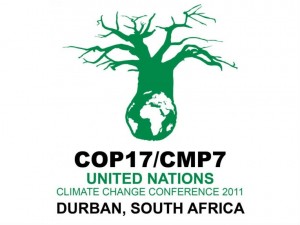After Durban: Not phasing out HFCs ‘indefensible’



EIA Global Environment Campaigner Natasha Hurley was in Durban last week for COP17, the United Nations Climate Change Conference 2011; here she considers the event and what needs to happen next.
 The outcome of this year’s United Nations Climate Conference, which drew to a close in Durban at the weekend, is an important step forward in terms of securing the credibility, even the survival, of the international climate regime.
The outcome of this year’s United Nations Climate Conference, which drew to a close in Durban at the weekend, is an important step forward in terms of securing the credibility, even the survival, of the international climate regime.
Unfortunately, it falls very short on substance and will delay meaningful action on climate change for a further decade unless Parties take the initiative to move faster and/or take additional action of their own accord.
Current emissions reduction pledges are significantly lower than what scientists tell us is necessary to limit global temperature rise to 2°C above pre-industrial levels. A recent report by the United Nations Environment Programme (“Bridging the Emissions Gap”[1]) shows that by 2020, and assuming perfect implementation of countries’ current pledges under the United Nations Framework Convention on Climate Change (UNFCCC), there will be a six-gigatonne gap between what is required to limit global temperature rise to 2°C and actual emissions. These pledges are further undermined by a number of ‘loopholes’ in the climate regime, including carbon offsets that do not represent real emissions reductions, the double counting of emissions reductions and the use of surplus emission allowances (AAUs) from the Kyoto Protocol‘s first commitment period after 2012[2].
The scale of the ambition gap underlines the importance of making rapid progress on securing a strong and legally binding agreement under the new Ad Hoc Working Group on the Durban Platform for Enhanced Action (AWG DPEA).[3] However, it also shows that in order to prevent the climate from reaching a devastating tipping point in the interim, significant emissions reductions will need to be secured at the soonest possible opportunity.
The global elimination of hydrofluorocarbons (HFCs) is one action which would buy the international community time to secure meaningful and legally binding commitments to slash carbon emissions before climate change spirals out of control. A worldwide phase-out of HFCs has the potential to avoid 88 to 140 gigatonnes of CO2-equivalent emissions reductions by 2050.[4] There is simply no other comparable near-term strategy for greenhouse gas mitigation nor prospect for eliminating an entire class of greenhouse gases.
Failure to seize this opportunity now would be an indefensible dereliction of duty. EIA calls on Parties to the Montreal Protocol and to the UNFCCC to make 2012 the year in which HFCs become history.
Current estimates suggest that the release of fluorinated greenhouse gases accounts for two per cent of global greenhouse gas emissions, about the same as the entire air transport sector.[5] This proportion is set to grow rapidly in the future as HFCs become more widely used in developing countries and demand for air conditioning and cooling soars. At current rates, F-gases could be responsible for 9-19 per cent of annual greenhouse gas emissions by 2050 (5.5-8.8 GT CO2-equivalent per year),[6] seriously undermining attempts to halt runaway climate change.
[1] http://www.unep.org/publications/ebooks/bridgingemissionsgap/
[2] http://www.cdm-watch.org/?p=2969 ; http://sei-us.org/Publications_PDF/SEI-WorkingPaperUS-1107.pdf
[3] Under the terms of last Sunday’s agreement, the AWG DPEA is required to complete its work no later than 2015. However, the new arrangements could enter into force as late as 2020.
[4] Information note submitted by the United States of America on hydrofluorocarbons, Open-ended Working Group of the Parties to the Montreal Protocol on Substances that Deplete the Ozone Layer Thirty-first meeting, August 2011; Velders et al. 2009 ‘The large contribution of projected HFC emissions to future climate forcing’ PNAS Vol. 106, No. 27, pp.10949-10954
[5] Becken & De Graaf et al. 2011 ‘Avoiding fluorinated greenhouse gases – Prospects for phasing out’ published by the German Federal Environment Agency (Umweltbundesamt).
[6] Velders et al. 2009 ‘The large contribution of projected HFC emissions to future climate forcing’ PNAS Vol. 106, No. 27, pp.10949-10954